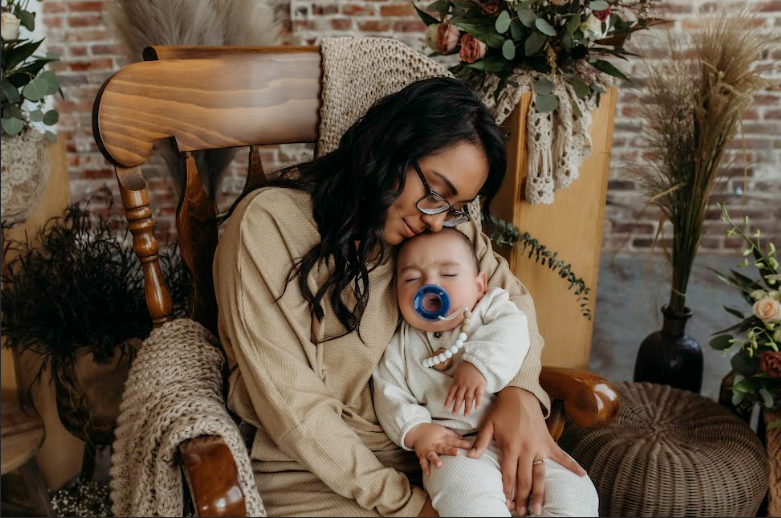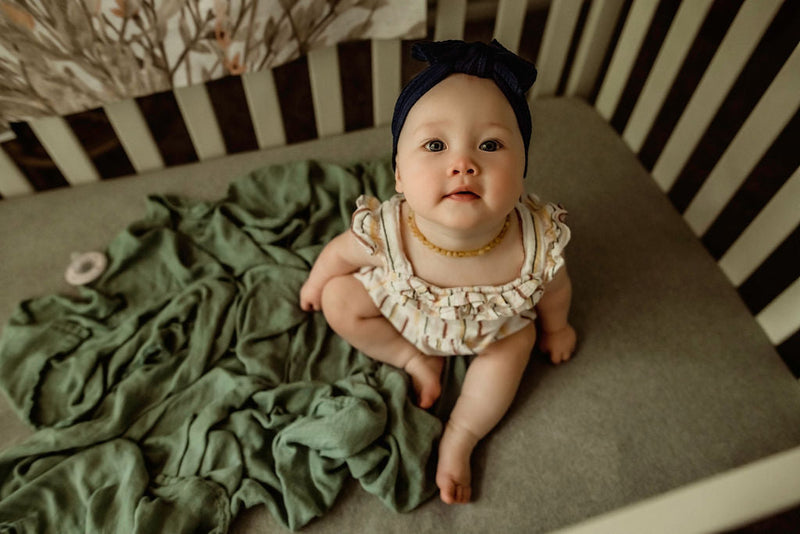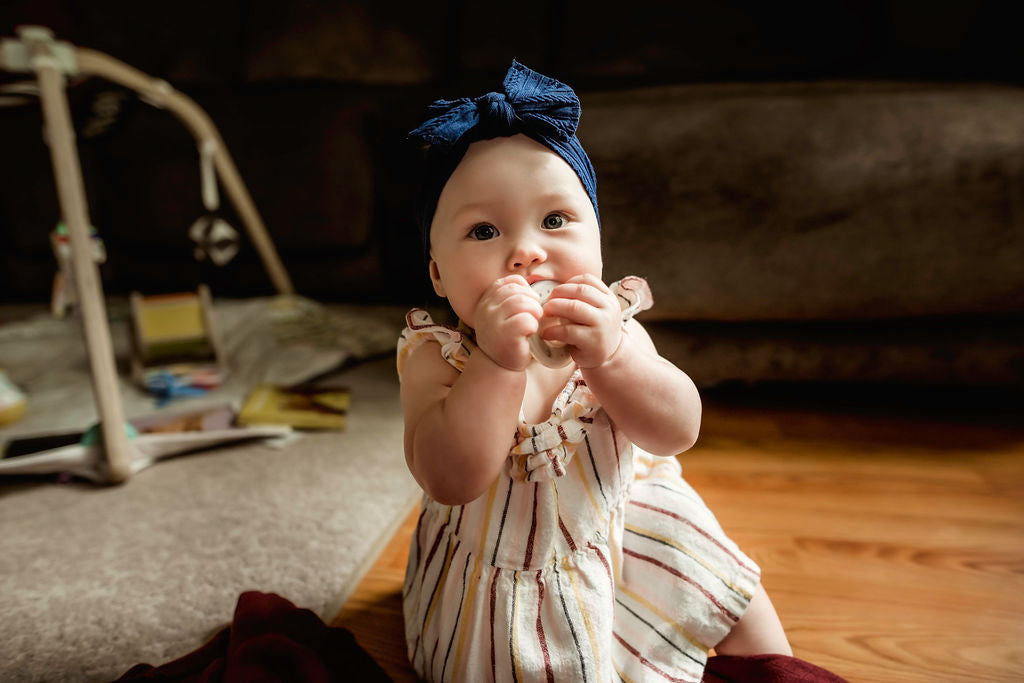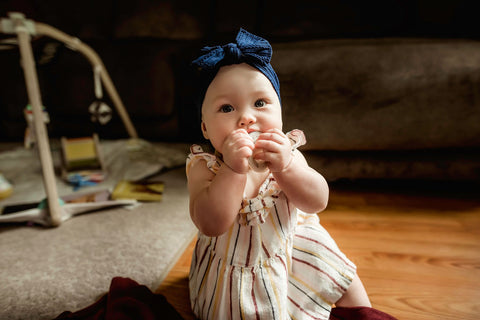
Early childhood is a time of rapid growth and development.
Your baby’s brain is adding new cells at a faster pace than at any other time in their lives. Every day brings exciting milestones and new skills.
But that rapid growth also makes young children especially vulnerable to harmful toxins in our environment.
It’s estimated that about 80,000 chemicals are used to make all kinds of products found in homes across the United States. On top of that, crawling and playing on the floor means infants get even more exposure to tracked-in or spilled chemicals from outside the home. Harmful chemicals can have many health effects during pregnancy, early childhood and well into the future - from lower birth rates to developmental delays to cancer.
That’s why it’s so important for parents to choose nontoxic products, according to Registered Dietician Allision Magier, founder of Well By Alli. As a nutritionist who specializes in pregnancy, postpartum and functional medicine, Magier uses rigorous criteria to test dozens of products before recommending them on her website.
“A lot of products are labeled ‘nontoxic’ or ‘clean’ but they actually are not,” she explains. “If they pass that test, then I like to try them out myself…From there, if they check all my boxes, then I will recommend the product.”
By choosing nontoxic products, you can protect your baby’s immediate health and reduce the risk of problems later in life. In this article, we share important information to help you shop with confidence to support the health and wellbeing of your family.
What Does Nontoxic Mean?
A product is considered toxic “if it can produce personal injury or illness to humans when it is inhaled, swallowed or absorbed through the skin,” according to the Consumer Product Safety Commission.
Toxic substances increase the risk of cancer, birth defects and neurotoxicity. In babies and young children, they also promote developmental issues, endocrine problems, thyroid disruption, asthma and other respiratory problems, poor immune health, ADHD, ADD and many more.
To qualify as nontoxic, products must be free of ingredients that have negative side effects on human health. For babies, the safest materials include natural fibers like cotton or bamboo, especially those grown without synthetic pesticides or fertilizers.
Here are other quality materials parents should look for:
- Silicone is a durable, nontoxic alternative to plastic. It is a good choice for pacifiers, teethers, cups and toys that will go inside the child’s mouth.
- Hypoallergenic means the product is free of allergens. Because this claim is not currently regulated, parents must read ingredient labels to be on the safe side.
- Food contact surfaces, such as table tops and utensils, should be FDA approved. This means they are corrosion-resistant and contain nontoxic materials.
- Vegan products are not only free of animal products or byproducts, they are also free of chemicals such as formaldehyde or chromium, which are found in materials such as leather.
Toxic Ingredients to Avoid
Magier offers a list of ingredients parents should avoid when choosing products that will come into contact with their baby. This includes products that baby may swallow, put in their mouths, inhale, absorb through the skin or touch.
BPA & Phthalates
Bisphenol A (BPA) and phthalates are both often used in plastics. Phthalates are known to cause hormone disruptions, while BPA affects a child’s growth, development and behavior.
PVCs
Polyvinyl chloride, or PVCs are found in plastic toys, bibs, mats and other items babies come into contact with. PVCs often contain lead and other phthalates which may lead to cancer, birth defects, reproductive issues and developmental delays.
Parabens
Parabens are used as preservatives in many products. These chemicals may interfere with the reproductive system.
BHA
Butylated hydroxyanisole, or BHA, is a synthetic antioxidant found in some foods and personal care products. Studies show it is reasonably anticipated to be a carcinogen, and may increase the risk of liver, thyroid and kidney problems.
BHT
Butylated hydroxytoluene, or BHT, is a synthetic antioxidant found in many skin care products and cosmetics. It can cause allergies and skin irritation in babies, with symptoms including painful itching, inflammation and redness.
VOCs
Volatile organic compounds, or VOCs, are chemicals that evaporate at room temperature. Examples include formaldehyde, benzene and ethylene glycol. They are released into the air when we use products that contain them. Babies and young children inhale VOCs in higher concentrations than adults, which increases their risk of respiratory issues, allergies and even cancer.
Fragrances, Perfumes & Dyes
Artificial fragrances and dyes in personal care products can harm the respiratory, cardiovascular and neurological systems.
Flame Retardants
Flame retardants cause many long-term health effects, including hormone disruption and some cancers.
Sulfates
Sulfates are found in many personal care products and may cause skin irritation and allergic reactions.
Chlorine
Chlorine is used in cleaning products and can cause respiratory problems, as well as skin and eye irritation.
Formaldehyde
Formaldehyde is a flammable gas used in many products, including building materials. It has been linked to cancer.
Tips for Safe Shopping
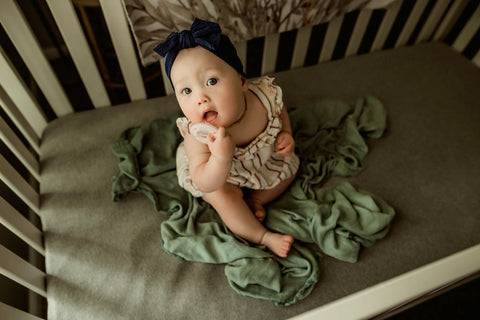
First of all, Magier acknowledges that it can feel overwhelming to switch out every product in your home. To simplify things, it’s best to make one change at a time.
What to Look For
Parents should study ingredients and manufacturing processes for harmful chemicals. Avoid ingredients like those listed above, such as formaldehyde, parabens and many synthetics. Choose organic materials and use brands that are free of unwanted additives whenever possible.
Finding Trustworthy Information
There’s no shortage of brands making health and safety claims in their advertising. Parents are also bombarded with social media messages promoting conspiracies or rumors that in many cases are simply not true.
How can you cut through the noise and separate fact from fiction when researching products for you and your family?
For starters, look for evidence of actual studies to support advertising claims or social media posts. If you can’t find any hard data to back it up, take it with a grain of salt.
You can also turn to reputable organizations like the Environmental Working Group and the Green Science Policy Institute. These organizations conduct extensive reviews to identify up-to-date research on chemicals of concern and lists of safe products. For example, EWG Verified for Baby maintains an extensive database of recommended products.
Specific Products
Prioritize products that your baby will be exposed to the most when writing out your safe shopping list. Here are a few examples of what to look for:
- Pacifiers, bottles and chew toys: For products that will go in baby’s mouth, look for materials like silicone or stainless steel.
- Shampoo, diaper creams and lotions: Personal care products for infants should be hypoallergenic and free of perfumes or dyes.
- Diapers and wipes: Choose brands made with unbleached pulp and chlorine-free bleach. Products should be fragrance-free, lotion-free and dye-free.
- Crib: Solid woods and nontoxic finishes are recommended.
- Crib mattresses: Look for natural fibers without harmful additives such as flame retardants. Many parents also choose latex-free to avoid potential allergy concerns.
- Blankets, crib sheets and bedding: Organic cotton is the safest material for baby’s bedding.
- Nursery paint: Zero-VOC paints will preserve air quality and minimize off-gassing to protect baby’s respiratory health.
Go Easy on Yourself!
Magier emphasizes that it is impossible to be perfect.
There are so many toxins in our everyday environment that it’s simply not realistic to escape them all. Instead of setting unreachable goals, take things one step at a time, making smart decisions whenever you can.
In order to help out, Magier created a Nontoxic Baby Guide for parents and parents-to-be. It breaks down every single product a baby could need, from the playroom to the nursery to diapering to clothing. You’ll also learn what to choose for cleaning, laundry, mold-free bath times and even healthy snacks when it’s time for solid foods.
She has also published a Well By Alli Nontoxic Guide for grownups. It offers many examples of safe products you can choose for the kitchen, cleaning, personal care and more.
Choosing a Safe Pacifier

When it comes to pacifiers, Magier recommends a BPA- and phthalate-free brand made with 100% medical grade silicone. Parents should also choose a breastlike shape that promotes healthy oral development.
When she was a new breastfeeding mama, Magier did lots of research on what the best pacifiers were. Like most moms, she felt completely overwhelmed by the different shapes, materials and other features. “I was left feeling defeated and confused because every website and every doctor told me something different,” she recalls.
Magier finally found Ninni through her own research, followed by approval from her International Board Certified Lactation Consultant (IBCLC). She was thrilled to find a nontoxic, safe pacifier that mimicked the natural suckling movements when her son latched. She was also impressed with the easy grip and round base with holes to facilitate baby’s breathing.
Although her son no longer uses a pacifier, the Ninni got him through the pacifier stage and gave Magier greater peace of mind!
